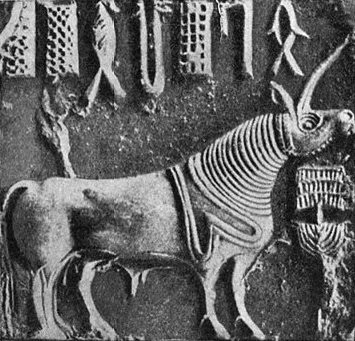First Unicorns? April 6, 2011
Author: Beach Combing | in : Ancient , trackbackBeachcombing is returning with some relief to familiar territory after the Shakespeare wars of the last couple of days. The subject: unicorns and the earliest human accounts of these mysterious creatures.
In the Indus Valley about 3000 BC a series of seals were created that portray an animal with one horn: they predate the mention of unicorns in the Bible by perhaps two thousand years (or more if as seems likely the Biblical unicorn is based on a mistranslation).
The unicorn is by far the most popular of the images found on these ‘documents’ from the dawn of civilization in the subcontinent. Of about 2000 seals at Mohenjodaro and Harappa that have been found, just under a thousand portray this mysterious creature.
The unicorn seals have certain features in common. First there is almost always what appears to be an incense burner in the corner of the image: though it is also possible that this ‘incense burner’ is meant to represent different crops found in the region – the seals would then relate to record-keeping relating to said crops.
The unicorns themselves are hardy creatures, looking more like bulls than the horsey unicorns of medieval and modern fantasy. They have a pizzle. They may have a saddle – though this is not clear. And they appear to have a contoured neck that may (or may not) represent a collar.
Beachcombing couldn’t be bothered to put ‘unicorns’ in inverted commas as he was going through this text. But many have argued that these creatures are nothing of the kind. They suggest that this is a simple bull seen in profile, so the second horn is to be imagined behind the visible close horn.Crucially there are some seals that seem to show the same animal with a turned head and two horns.
Other writers have contended that this is the mythic unicorn – perhaps glimpsed in Vedic texts. There are also scholars who believe that there really was a one horned beast in the woods of ancient India.
Beachcombing always enjoying the perversity of history wonders if this wasn’t bos primigenius drawn in profile, but that the frequency of the image and its apparent single horn led to the myth of the unicorn in early India and from there in the world. Humanity fooled by its own puppet show.
Certainly, whereas Beachcombing feels he understands the origins of werewolves, vampires, fairies and the like, he hasn’t the slightest idea where the unicorn comes from – though if a pistol was pointed at his head he would guess the rhinoceros.
Any other thoughts on the unicorn seals: drbeachcombing AT yahoo DOT com
***
30 April 2011: RuthWA writes in: ‘I’m familiar with farm animals and your picture really looks like a big bull to me–standing in profile. My husband went to an ag college for several years and I saw a lot of bulls that looked like that. Maybe the person who thought it was a Unicorn wasn’t overly familar with them?’ Thanks Ruth!
1 May 2011: ‘My vote [for the origins of unicorns] is for the elasmotherium for the really ancient accounts. The medieval accounts of a deer-like creature influenced by virgins seems paranormal, like the phoenix, for example. From Wikipedia; ‘One suggestion is that the unicorn is based on the extinct animal Elasmotherium, a huge Eurasian rhinoceros native to the steppes, south of the range of the woolly rhinoceros of Ice Age Europe. Elasmotherium looked little like a horse, but it had a large single horn in its forehead. It became extinct about the same time as the rest of the glacial age megafauna. However, according to the Nordisk familjebok (Nordic Familybook) and science writer Willy Ley the animal may have survived long enough to be remembered in the legends of the Evenk people of Russia as a huge black bull with a single horn in the forehead. In support of this claim, it has been noted that the 13th century traveller Marco Polo claimed to have seen a unicorn in Java, but his description makes it clear to the modern reader that he actually saw a Javan Rinoceros.’’ Thanks KMH and thanks Ruth!!



